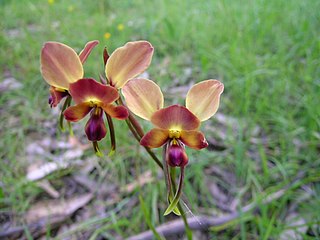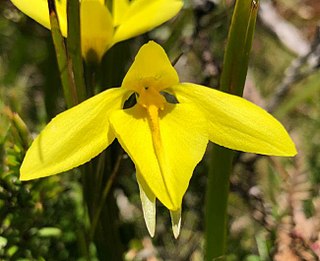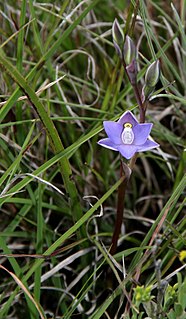
Diuris pardina, commonly known as the leopard orchid or leopard doubletail is a species of orchid which is endemic to south-eastern Australia. It has two or three grass-like leaves and up to ten yellow flowers with reddish-brown marks and blotches.

Diuris behrii, commonly known as golden cowslips, is a species of orchid which is endemic to eastern Australia. It occurs in South Australia, Victoria, New South Wales and the Australian Capital Territory. It has between three and six grass-like leaves and a flowering stem with up to four drooping, yellow flowers with dark streaks on the labellum. The flowers appear between September and November in its native range.

Diuris sulphurea, commonly called the tiger orchid or hornet orchid, is a species of orchid which is endemic to eastern Australia. It has up to three leaves, and a flowering stem with up to seven bright yellow flowers with dark brown markings.

Diuris protena, commonly known as northern golden moths, is a species of orchid which is endemic to Victoria. It has a tuft of between four and eight leaves at the base and up to three mostly yellow flowers with a few light-coloured marks. It is classed as "endangered" in Victoria.

Diuris chryseopsis, commonly known as common golden moths or the small snake orchid, is a species of orchid that is endemic to south-eastern Australia. It is a common and widespread species growing in woodland, often in colonies and has up to four drooping, golden-yellow flowers. It is similar to several other orchids and form hybrids with some other Diuris species.

Diuris orientis, commonly called the wallflower orchid or eastern wallflower orchid, is a species of orchid which is endemic to eastern Australia. Like others in the genus Diuris, it has two ear-like petals and is similar to the common donkey orchid of Western Australia with which it has been confused. This species is found in New South Wales, Victoria, South Australia and Tasmania and its stalk-like petal "claw" is shorter in than those of D. corymbosa.

Diuris basaltica, commonly known as little golden moths, or small golden moths is a species of orchid which is endemic to Victoria. The species has suffered a catastrophic reduction in range and distribution as a result of clearing for agriculture, then by urban expansion until only about four hundred plants remain in the wild.

Diuris punctata, commonly known as the purple donkey orchid is a species of orchid which is endemic to south-eastern continental Australia. It has two grass-like leaves and up to ten purple or mauve flowers, often with darker, sometimes yellow marks. A yellow form from near Guyra is probably now extinct.
Diuris curta is a species of orchid that is endemic to eastern Australia. It has one or two leaves and up to five bright yellow flowers with two small dark spots on the dorsal sepal. It grows on coastal headlands between about Byfield in Queensland and Hat Head in New South Wales.
Diuris flavescens, commonly called the pale yellow doubletail or Wingham doubletail, is a species of orchid which is endemic to a small area in New South Wales. It has two linear leaves at its base and up to five pale yellow flowers with dark brown markings. Fewer than 200 plants survive in grassy forest near Wingham.
Diuris fucosa is a species of orchid that is endemic to New South Wales. It between four and seven leaves and up to four pale yellow flowers with a few brown striations. It is only known from two sites in Callitris woodland in the south of the state and is classed as "extinct" in Victoria.

Diuris lanceolata, commonly known as large golden moths, is a species of orchid that is endemic to Tasmania. It has between two and four leaves and up to three golden to orange-yellow flowers with a few dark streaks.
Diuris micrantha, commonly called the dwarf bee orchid or tiny bee orchid, is a rare species of orchid which is endemic to the south-west of Western Australia. It has four to six linear leaves at its base and up to six yellow flowers with reddish brown markings. It grows in swampy places south of Perth.

Diuris monticola, commonly known as highland golden moths, is a species of orchid that is endemic to south-eastern Australia. It is a common and widespread, late flowering species growing in grassland and woodland habitats at higher altitudes. It has a tuft of up to nine leaves at the base and up to four slightly drooping bright yellow flowers with dark streaks in the centre.

Diuris palustris, commonly known as the swamp doubletail or swamp diuris is a species of orchid which is endemic to south-eastern Australia. It has a tuft of between eight and ten twisted leaves and up to four yellow flowers with brown spots and blotches marks and blotches.
Diuris platichila, commonly known as the Blue Mountains doubletail, is a species of orchid that is endemic to a few isolated places in the Blue Mountains in New South Wales. It has two leaves and up to eight yellow flowers with dark markings on the dorsal sepal and labellum. It has relatively long, thin lateral sepals and the central lobe of the labellum is wedge-shaped. It forms hybrids with other species of Diuris.
Diuris recurva, commonly called the mini donkey orchid is a species of orchid that is endemic to the south-west of Western Australia. It has one or two leaves at its base, up to six small pale yellow and brownish flowers and grows in winter-wet places between Badgingarra and Kalbarri.
Diuris tricolor, commonly known as the long-tailed donkey orchid or pine donkey orchid, is a species of orchid that is endemic to New South Wales, although a single plant has been found in Victoria. It has up to three grass-like leaves and up to six orange-coloured to yellow flowers with white and purplish tints. The lateral sepals are unusually long.
Diuris unica is a species of orchid which is endemic to eastern Australia. It usually has only one grass-like leaf at its base and up to eight bright, lemon-yellow flowers with a few dark markings. It is similar to D. chrysantha but flowers much earlier than that species and has only a single leaf rather than two.

Thelymitra gregaria, commonly called the clumping sun orchid, is a species of orchid that is endemic to Victoria. It has a single fleshy, channelled leaf and up to six strongly scented, dark blue to purple flowers and often grows in clumps.












